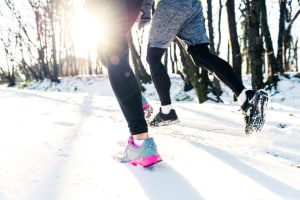Keep Your Outdoor Winter Workouts Safe
 Many people are of the mindset that when the leaves start to change colors and fall to the ground, it is time to move their workouts indoor. You can certainly do this if you wish, but you can continue to safely workout outdoors. Here are some suggestions to keep yourself healthy and safe.
Many people are of the mindset that when the leaves start to change colors and fall to the ground, it is time to move their workouts indoor. You can certainly do this if you wish, but you can continue to safely workout outdoors. Here are some suggestions to keep yourself healthy and safe.
- When you exercise, blood flows to your core, which means your hands, feet and ears can get cold quickly. Wear gloves, a warm hat and earmuffs. A scarf protects your face and neck from the damaging cold and wind. Protect your feet. Wear only one layer of socks and choose a pair designed to wick away moisture.
- Wear bright, reflective clothing so you will be seen in the dark. Always carry a charged cell phone with you and let someone know where you are going and when you will return.
- Keep yourself hydrated, this includes before your workout, during and once you finish. In colder weather, you may not feel as thirsty, but your body still loses fluids through respiration and sweat. This makes it easier to become dehydrated, which can lead to decreased performance and increased muscle soreness.
- Wear layers of clothing: To stay at an ideal temperature, consider three basic layers of workout clothes made of moisture-wicking materials: Base layer: Wear breathable clothing to wick excess sweat off your skin. Avoid heavy fabrics that absorb sweat like cotton in favor of water-resistant materials such as polyester. Mid layer: This layer should protect you from the cold and lock in warm air around your body. Adjust your mid layer based on your workout environment. If it is cold or freezing, opt for a thick down jacket. In cool weather, a fleece fabric may be sufficient. If it feels hot, you can skip a mid layer. Outer layer: The final outer layer is intended to protect you from elements such as rain, snow, and wind. Select waterproof and water-resistant materials that are still breathable.
- Warm-up indoors: performing a five- to 10-minute dynamic warm-up can help the body gradually adjust for winter workouts. Start indoors with 30 to 60 seconds of foam rolling your calves, hip flexors, quadriceps, lats, and pectoral muscles.
- Wear sunscreen, lip balm and eye protection. The cold air, wind and the suns reflection off the snow can damage your eyes and skin. If it is a snowy or icy day, put spikes, cleats or YakTracks on your shoes for improved traction. (Yak Trax, Ice Trax, Aliglow slip on spikes, run traction cleats)
Know the signs of frostbite and hypothermia: Frostbite is most common on exposed skin, such as your cheeks, nose and ears. It can also occur on hands and feet. Early warning signs include numbness, loss of feeling or a stinging sensation. Immediately get out of the cold if you suspect frostbite. Slowly warm the affected area — but don't rub it because that can damage your skin. Seek emergency care if numbness doesn't go away. Hypothermia signs and symptoms include: Intense shivering, slurred speech, loss of coordination, fatigue.
Photo: ©iStock.com/Georgijevic